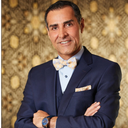I am currently investigating facelift and lower eyelid surgery. I have two doctors that I've narrowed down to perform different types of lifts. One uses a more traditional SMAS type lift (45 degree vector) and the other an ENT Dr. suggested a deep plane lift (60 degree vector). What is your opinion of which lift might be better for a 56-year-old woman with a very saggy neck? Both doctors said they would place a suture under my neck.
Answers (45)
From board-certified doctors and trusted medical professionals
Dr. Brent Moelleken, MD

Dr. Brent Moelleken, MD
Beverly Hills Plastic Surgeon
Answer
Dr. Matthew Richardson, MD

Dr. Matthew Richardson, MD
Board Certified Facial Plastic Surgeon
Answer
Dr. Theda C. Kontis, MD

Dr. Theda C. Kontis, MD
Board Certified Facial Plastic Surgeon
Answer
Dr. Jonathan Kulbersh, MD

Dr. Jonathan Kulbersh, MD
Board Certified Facial Plastic Surgeon
Answer
Dr. Jose Barrera, MD

Dr. Jose Barrera, MD
Board Certified Facial Plastic Surgeon
Answer
Dr. Alexander Donath, MD, FACS

Dr. Alexander Donath, MD, FACS
Board Certified Facial Plastic Surgeon
Answer
Dr. James Murphy, FRCS(Plast)

Dr. James Murphy, FRCS(Plast)
Specialist Registered Plastic Surgeon
Answer
Dr. Austin Hayes, MD

Dr. Austin Hayes, MD
Board Certified Plastic Surgeon
Answer
Dr. Jerome Edelstein, MD

Dr. Jerome Edelstein, MD
Certified Plastic Surgeon
Answer
Dr. Kevin Sadati, DO

Dr. Kevin Sadati, DO
Facial Plastic Surgeon, Board Certified in Otolaryngology – Head and Neck Surgery
Answer
Dr. Ronald J. Edelson, MD

Dr. Ronald J. Edelson, MD
Board Certified Plastic Surgeon
Answer
More Facelift Questions
See all Facelift Q&AWE SEND PRETTY
EMAILS
What’s trending? Who’s turning heads? Which TikTok myths need busting? We’ve got you. No fluff, no gatekeeping—just real talk. Get our free, unfiltered newsletter.